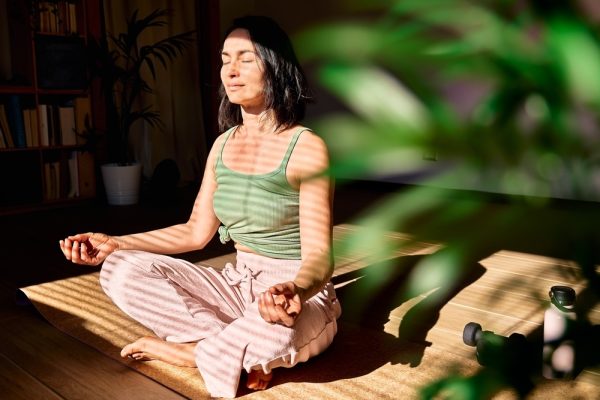As modern yoga practitioners, we often find ourselves seeking balance, inner peace, and a deeper connection with ourselves. Fortunately, the ancient practice of yoga offers us a profound framework to navigate this journey – the Eight Limbs of Yoga.
The eight limbs of yoga, also known as Ashtanga, are a fundamental part of yoga philosophy from the Yoga Sutras of Patanjali. Each limb offers guidance on how to live a balanced and fulfilling life. In this blog post, we will look into the eight limbs of yoga.
Yama
Yama, the first limb of yoga, encompasses the principles of moral disciplines and restraints. It guides practitioners on how to interact harmoniously with others and live in alignment with ethical values.
Yama consists of five principles:
- Ahimsa (non-violence), emphasizing compassion and non-harming
- Satya (truthfulness), encouraging honesty and authenticity
- Asteya (non-stealing), promoting integrity and non-greediness
- Brahmacharya (right use of energy), fostering moderation and self-control;
- Aparigraha (non-attachment), urging non-possessiveness and letting go of material desires.
These principles serve as a foundation for developing inner peace, creating healthy relationships, and contributing positively to the world around us.
Niyama
The Niyamas, a part of Yoga philosophy, are the positive duties and observances that guide individuals on their spiritual journey. Niyama helps us cultivate a positive mindset and deepen our spiritual connection. Complementing the Yamas, the Niyamas focus on personal practices and self-discipline. It includes five practices:
- Saucha (cleanliness) – emphasizes the importance of keeping the body and mind clean and pure.
- Santosha (contentment) – encourages cultivating contentment and gratitude for what one has in life.
- Tapas (self-discipline) – refers to the practice of self-discipline and inner fire. It involves making conscious efforts to overcome obstacles and develop inner strength, both physically and mentally.
- Svadhyaya (self-study) – involves introspection, studying sacred texts, and gaining knowledge about oneself.
- Ishvara Pranidhana (surrender to a higher power) – involves recognizing that there is a greater force at work and trusting in its guidance. By surrendering the ego and cultivating humility, one can find inner peace and connection with the universe.
Asana
Asana, the third limb of yoga, refers to the physical postures practiced in yoga (asana postures). It is the aspect of yoga that is most commonly associated with the physical body. Through the practice of asanas, practitioners engage in a series of yoga poses that promote strength, flexibility, balance, and alignment.
The practice of asanas goes beyond simply performing physical movements. It involves cultivating mindfulness and awareness of the body and breath while maintaining a steady and comfortable posture. Asanas are not about achieving perfection or contorting the body into extreme positions. Instead, they are about finding a balance between effort and ease, allowing the practitioner to experience both physical and mental benefits. You might also be interested in the benefits of Vinyasa yoga.
Pranayama
Pranayama, an integral part of yoga practice, involves the regulation and breath control. Originated from the Sanskrit words “prana” (life force) and “ayama” (control or extension), pranayama aims to harness and elevate the prana-shakti, or life energies, within us.
Pranayama techniques encompass a variety of breathing techniques and exercises that are practiced for physical, mental, and emotional well-being. By consciously manipulating the breath, practitioners can influence their energy levels, calm the mind, and promote overall balance and vitality.
Pratyahara
Pratyahara, the “forgotten limb” of yoga, is the conscious withdrawal of energy from the senses. It is the fifth limb of Ashtanga yoga, known as the eight-limbed path. Pratyahara is foundational for meditation and deepening spiritual practice.
During pratyahara, practitioners use techniques to withdraw attention and energy from external sensory stimuli. This involves blocking sensory openings in the head, like the eyes, ears, nostrils, and mouth, with the fingers. By turning attention inward, individuals shift focus from the external world to the inner realm.
Pratyahara allows practitioners to detach from distractions and cultivate stillness and introspection. It enables observation of thoughts, emotions, and sensations without entanglement. Through withdrawing from the senses, individuals gain greater control over mental and emotional states.
 Dharana
Dharana
Dharana, the sixth limb of yoga, is the practice of concentration and focusing the mind on a single point. It trains the mind to be steady and free from distractions. During dharana, practitioners develop the ability to direct their attention and energy towards a specific point. This is achieved through techniques like mantra repetition, visualizations, or gazing at an object.
Dharana cultivates mental clarity, discipline, and inner strength, leading to a state of deep absorption and heightened awareness. By incorporating dharana into a yoga practice, individuals can explore themselves and connect with the present moment action with other yogic practices such as pranayama or meditation.
Dhyana
Dhyana refers to the ancient meditation practices that have been cherished for centuries. In this profound limb of yoga, we embark on a transformative journey where we cultivate a state of deep awareness and inner calm.
Through dedicated and regular Dhyana meditation, we are able to transcend the boundaries of the mind and tap into a realm of pure consciousness. It is in this sacred space that we experience a profound sense of oneness and unity with the present moment, unlocking the potential for true self-realization and inner peace.
Samadhi
Samadhi, the ultimate goal of yoga, is often described as a state of profound enlightenment and blissful union with the universe. It is a transcendent state where the practitioner experiences complete absorption, effortlessly transcending the limitations of the physical body and the confines of the mind.
In this exalted state, one attains a deep sense of connection to the divine, experiencing a profound union with the eternal essence of existence itself. Samadhi is the pinnacle of spiritual attainment, a sacred realm where the boundaries of the self dissolve, and the practitioner becomes one with the infinite cosmic consciousness.
By incorporating all eight limbs of yoga into our practice, we can lead a balanced and harmonious life, nurturing both our physical and spiritual well-being. These limbs provide a comprehensive framework for personal growth and transformation.


 Dharana
Dharana

